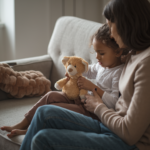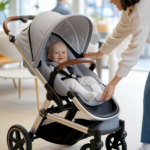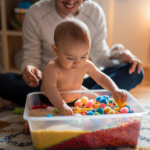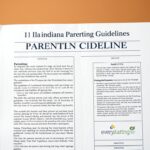As your baby grows and becomes more mobile, ensuring your home is safe becomes increasingly important. Babyproofing home involves making your living space secure to prevent accidents and injuries. This comprehensive guide will walk you through the essential steps to babyproof your home effectively, providing peace of mind as your little one explores their environment.
Why Babyproofing Your Home Matters
Babies are naturally curious and eager to explore their surroundings. Without proper safety measures, your home can pose numerous hazards. Babyproofing home is crucial to:
1. Prevent Accidents and Injuries
Babies are prone to falling, choking, and other accidents as they learn to crawl, stand, and walk. Babyproofing reduces the risk of these incidents by removing or securing potential dangers.
2. Promote Independent Exploration
A safe environment allows your baby to explore freely, fostering their independence and confidence. When you know your home is secure, you can let your baby discover new things without constant worry.
3. Create a Peaceful Environment
Knowing that your home is babyproofed provides peace of mind, allowing you to focus on other aspects of parenting and daily life without the constant fear of accidents.
Key Areas to Babyproof in Your Home
When babyproofing home, it’s essential to focus on specific areas where hazards are most likely to occur. Here are the key areas to address:
1. Living Room and Common Areas
- Secure Furniture: Use anti-tip brackets to anchor heavy furniture like bookshelves, dressers, and TVs to the wall to prevent tipping.
- Cover Electrical Outlets: Install outlet covers or safety plates to prevent your baby from inserting objects into sockets.
- Hide Cords: Use cord organizers or tape to keep electrical cords out of reach, reducing the risk of strangulation or electrical hazards.
- Corner Protectors: Apply corner and edge bumpers to sharp furniture edges to prevent injuries.
2. Kitchen
- Cabinet Locks: Install childproof locks on cabinets and drawers to keep harmful substances like cleaning supplies and sharp objects out of reach.
- Stove Knob Covers: Use stove knob covers to prevent your baby from turning on the burners.
- Appliance Locks: Secure appliances like refrigerators, ovens, and microwaves with childproof locks.
- Safe Storage: Store knives, scissors, and other sharp utensils in locked drawers or high cabinets.
3. Bathroom
- Toilet Locks: Install toilet locks to prevent your baby from opening the lid and potentially falling in.
- Non-Slip Mats: Use non-slip mats in the bathtub and on bathroom floors to prevent slips and falls.
- Medicine and Cleaning Products: Keep medications and cleaning products in high, locked cabinets to keep them out of reach.
- Water Temperature: Set your water heater to a safe temperature (below 120°F) to prevent scalding.
4. Nursery
- Crib Safety: Ensure the crib meets current safety standards, with a firm mattress and no loose bedding, pillows, or toys.
- Furniture Stability: Anchor the crib and changing table to the wall to prevent tipping.
- Cord Management: Keep blinds and curtains cords out of reach by using cordless window treatments or securing cords high on the wall.
- Toy Safety: Choose age-appropriate toys without small parts that could pose choking hazards.
5. Staircase
- Safety Gates: Install safety gates at both the top and bottom of the stairs to prevent falls.
- Gate Height and Durability: Ensure the gates are tall enough to prevent your baby from climbing over and sturdy enough to withstand attempts to open them.
- Proper Installation: Follow the manufacturer’s instructions carefully to ensure the gates are securely installed.
Step-by-Step Guide to Babyproofing Your Home
Babyproofing your home doesn’t have to be overwhelming. Follow these steps to create a safe environment for your baby:
1. Conduct a Safety Audit
Begin by walking through your home and identifying potential hazards. Look for sharp edges, accessible cords, open cabinets, and small objects that could be choking hazards.
2. Prioritize High-Risk Areas
Focus on areas where your baby spends the most time, such as the living room, kitchen, and nursery. These areas typically contain the most potential hazards.
3. Implement Safety Measures
Apply the necessary safety measures to each identified hazard. Use the guidelines provided in the previous section to secure furniture, cover outlets, install locks, and more.
4. Regularly Update Babyproofing Measures
As your baby grows and becomes more mobile, revisit and update your babyproofing measures. Ensure that new hazards are addressed promptly to maintain a safe environment.
5. Educate Household Members
Ensure that everyone in the household understands the babyproofing measures and follows them consistently. This includes grandparents, babysitters, and visitors.
Expert Tips for Effective Babyproofing
Here are some expert tips to enhance your babyproofing efforts:
1. Use Safety Products Wisely
Choose high-quality safety products that meet current safety standards. Avoid using makeshift solutions, as they may not provide adequate protection.
2. Keep Hazardous Items Out of Reach
Store all hazardous items, including medications, cleaning supplies, and sharp objects, in locked cabinets or high shelves where your baby cannot access them.
3. Secure Heavy Furniture
Anchoring heavy furniture to the wall is one of the most effective ways to prevent tipping accidents. Even lightweight furniture can cause harm if tipped over.
4. Install Window Guards
Window guards prevent your baby from falling out of open windows. Ensure that the guards are securely installed and cannot be easily removed by your baby.
5. Monitor Toy Safety
Regularly inspect your baby’s toys for broken parts or wear and tear. Remove any damaged toys that could pose choking hazards or other safety risks.
6. Create Safe Play Areas
Designate specific areas in your home where your baby can play safely. Use playpens or gated areas to keep your baby contained while allowing them to explore.
Internal and External Links for Enhanced SEO
To further enhance the SEO of this article, it’s important to include both internal and external links. Internal links connect to other relevant articles on your website, improving site navigation and authority. External links point to reputable sources, adding credibility to your content.
Internal Links:
- How to Encourage Independent Play in Babies
- The Importance of Outdoor Play for Babies
- How to Create a DIY Sensory Bin for Your Baby
External Links:
Benefits of Babyproofing Your Home
Babyproofing home offers numerous benefits that contribute to your baby’s safety and development:
1. Peace of Mind for Parents
Knowing that your home is safe allows you to relax and enjoy time with your baby without constant worry about potential hazards.
2. Encourages Safe Exploration
A babyproofed environment encourages your baby to explore freely and safely, promoting their natural curiosity and learning.
3. Reduces the Risk of Accidents
Effective babyproofing significantly reduces the likelihood of accidents and injuries, ensuring your baby’s safety as they grow and become more active.
4. Supports Developmental Milestones
A safe environment allows your baby to practice new skills, such as crawling and walking, without the risk of falling or encountering obstacles.
Common Babyproofing Mistakes to Avoid
Avoid these common mistakes to ensure your babyproofing efforts are effective:
1. Overlooking Less Obvious Hazards
Don’t just focus on obvious dangers like sharp edges and accessible cabinets. Consider less obvious hazards such as electrical appliances, heavy furniture, and small objects.
2. Using Inadequate Safety Products
Ensure that all safety products are high-quality and meet current safety standards. Avoid using cheap or makeshift solutions that may not provide adequate protection.
3. Neglecting Regular Maintenance
Babyproofing is not a one-time task. Regularly inspect and maintain safety measures to ensure they remain effective as your baby grows and explores more areas of your home.
4. Not Involving All Household Members
Ensure that everyone in the household understands and follows the babyproofing measures consistently. Inconsistencies can lead to accidents and undermine your safety efforts.
Conclusion: Creating a Safe Haven for Your Baby
Babyproofing home is an essential step in ensuring your baby’s safety and fostering their development. By systematically identifying and addressing potential hazards, you create a secure environment where your baby can explore, learn, and grow with confidence. Follow this ultimate guide to babyproofing your home, and enjoy the peace of mind that comes with knowing your little one is safe.














